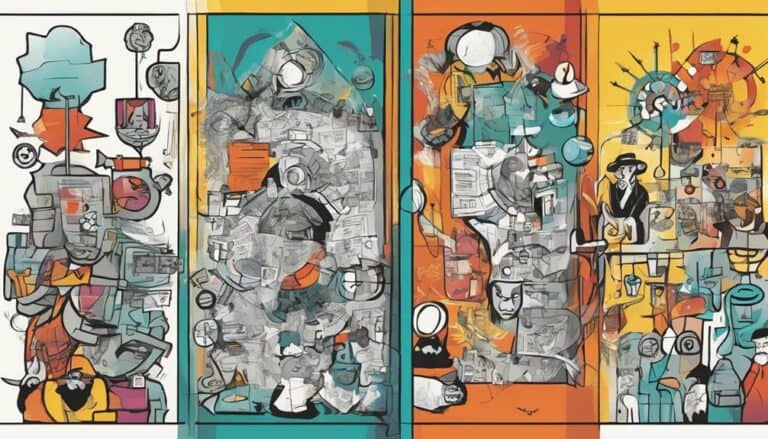You may not be aware that tailoring a decision-making framework to different organizational cultures involves more than just surface-level adjustments.
Understanding the intricacies of various cultural dynamics within an organization is essential for effective decision-making processes.
By recognizing the nuances in how different cultures approach decision-making and adapting tools and processes accordingly, organizations can enhance communication, inclusivity, and overall organizational effectiveness.
Stay tuned to discover the specific strategies and considerations that can help align decision-making frameworks with diverse organizational cultures and drive success.
Key Takeaways
- Customize decision-making tools to fit diverse cultural dimensions.
- Adapt frameworks to align with core organizational values.
- Integrate cultural sensitivity into decision-making processes.
- Foster inclusivity by respecting and embracing cultural differences.
Understanding Organizational Cultural Dynamics
To effectively navigate organizational decision-making, it's imperative to first grasp the intricate dynamics of your organization's culture. Culture plays a pivotal role in shaping the way decisions are made within a company. Different organizational cultures may prioritize various values such as efficiency, employee well-being, collaboration, or sales performance. Understanding these core values is essential in aligning your decision-making processes with the cultural norms and beliefs prevalent in your work environment.
Additionally, recognizing the dominant cultural dimensions like power distance, individualism, uncertainty avoidance, and long-term orientation can guide the customization of decision-making frameworks to better suit your organizational culture. By adjusting these frameworks to accommodate diverse subcultures within the company, you foster inclusivity and engagement among employees. Flexibility and adaptability are key in tailoring decision-making frameworks to make sure they align with the unique cultural dynamics of your organization.
Adapting Decision-Making Tools
Understanding the unique communication styles and power dynamics within your organization is key when adapting decision-making tools to align with different organizational cultures.
To effectively tailor decision-making tools, consider the following:
- Adjusting Communication Styles: Tailoring communication methods to fit the preferences of each organizational culture can enhance understanding and collaboration.
- Recognizing Hierarchy and Power Dynamics: Adapting decision-making tools to acknowledge and work within the existing hierarchy and power structures can lead to smoother implementation.
- Embracing Flexibility: Building flexibility into decision-making frameworks allows for accommodating various cultural norms and values, fostering inclusivity and engagement.
Aligning Framework With Cultural Values
Align your decision-making framework with the core values and beliefs of each organizational culture to guarantee effective alignment and resonance. Understanding the unique cultural norms, communication styles, and decision-making processes within each culture is vital for this alignment. Flexibility in the framework allows for adaptations that cater to the diverse characteristics and priorities of different organizational cultures. Incorporating feedback from employees representing various cultural backgrounds is key in customizing the decision-making framework to make sure inclusivity and relevance. By aligning your framework with the cultural values and beliefs of each organizational culture, you can create a more cohesive and cooperative decision-making environment that leads to better outcomes.
| Cultural Values | Alignment Strategies |
|---|---|
| Core Values | Align decision-making principles with the core values of each culture. |
| Beliefs | Incorporate cultural beliefs into the decision-making framework. |
| Communication Styles | Adapt communication methods to suit the preferred styles within each culture. |
| Decision-Making Processes | Modify decision-making processes to reflect the norms of each organizational culture. |
Customizing Processes to Fit Culture
Tailoring decision-making processes to fit the unique cultural dynamics of each organization enhances alignment and fosters a more cohesive operational environment. When customizing decision-making frameworks to fit culture, consider the following:
- Incorporating Cultural Values: Integrate the core values and beliefs of the organization into the decision-making processes to guarantee they resonate with the cultural identity.
- Adapting Communication Styles: Adjust the communication methods and channels used in decision-making to align with the preferred communication styles within the organization, promoting clearer understanding and engagement.
- Aligning with Organizational Norms: Customize decision-making processes to adhere to the established norms and practices within the organization, facilitating smoother implementation and acceptance of decisions.
Implementing Cultural Sensitivity in Framework
To enhance the cultural sensitivity of decision-making frameworks, consider incorporating diverse perspectives and communication styles to foster inclusivity and engagement within your organization. By recognizing and respecting cultural differences, you can create a more inclusive environment that values varying viewpoints and approaches. Adapting decision-making structures to accommodate different levels of hierarchy and collaboration aligns with diverse cultural preferences, promoting a more cohesive decision-making process.
| Cultural Sensitivity | Organizational Cultures | Decision-Making Framework |
|---|---|---|
| Embrace diversity in perspectives | Understand cultural norms and values | Incorporate different communication styles |
| Respect cultural differences | Foster inclusivity and engagement | Adapt structures for varying hierarchy levels |
| Provide training on cultural sensitivity | Promote collaboration | Enhance alignment with organizational cultures |
Conclusion
To sum up, tailoring a decision-making framework to different organizational cultures involves understanding the unique values and norms of each culture, adapting tools and processes to fit those preferences, and aligning the framework with cultural values.
For example, a multinational corporation successfully implemented a decision-making framework that incorporated both individualistic and collectivist approaches, leading to increased employee engagement and innovative solutions.
By embracing cultural diversity and sensitivity, organizations can cultivate a more inclusive and effective decision-making process.

